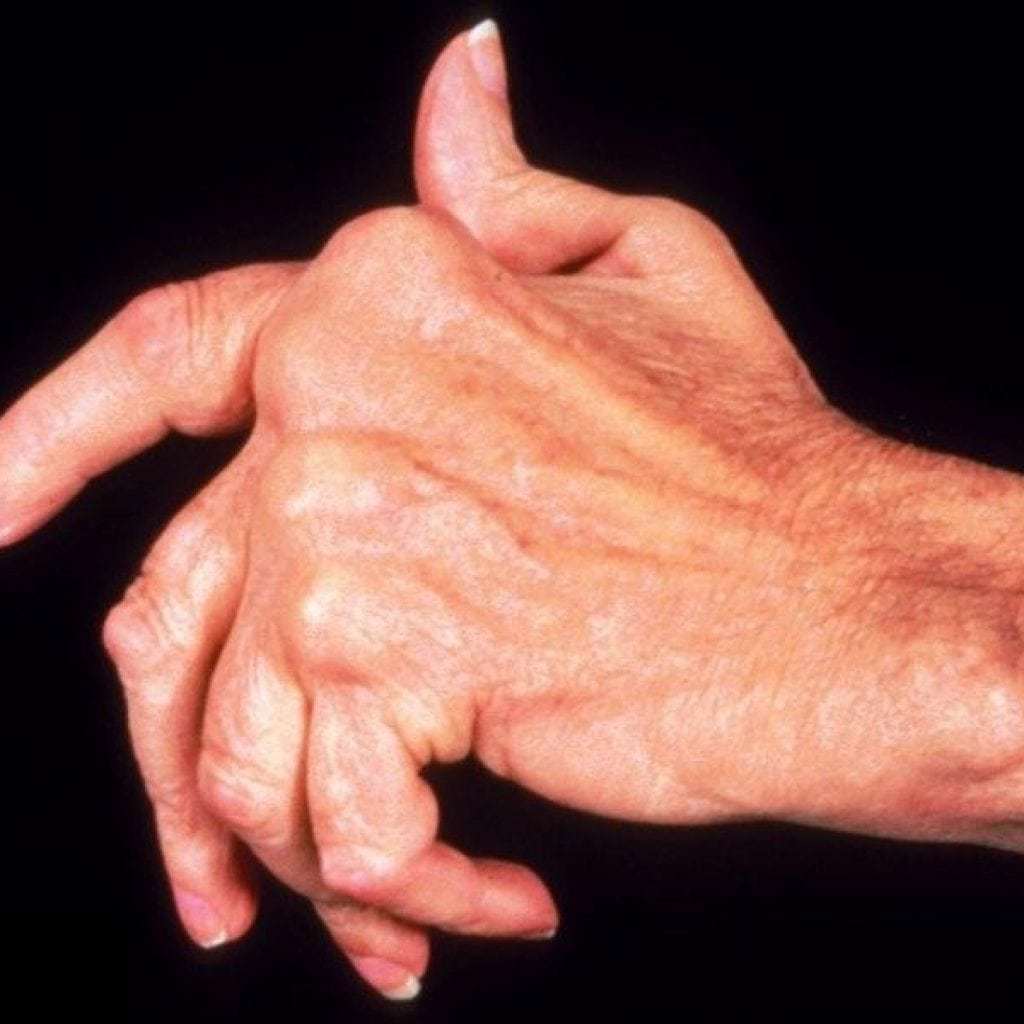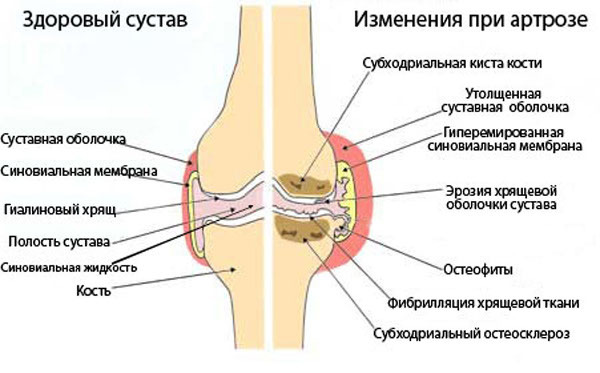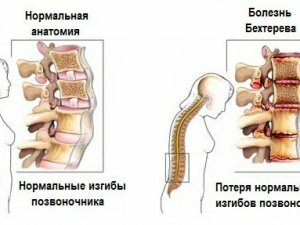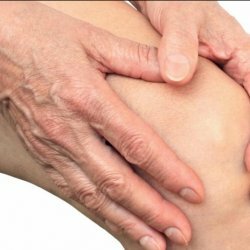Rheumatic arthritis: causes, symptoms and treatment
Rheumatic arthritis is a chronic form of a pathological inflammatory process that most often affects the joints of the upper and lower extremities, less often the joints of the whole body.
Counts autoimmune disease and, according to doctors, most often it is provoked by genetic disorders, less often - malnutrition and the patient's improper lifestyle, bad habits.
Content
- Causes of rheumatic polyarthritis
- Symptoms
- Diagnostics
- Treatment of rheumatic arthritis
- Drug treatment
- Complementary and alternative treatments
- Physiotherapy
- Aromatherapy
- Nutrition for illness
- Prophylaxis
- Complications and projections
- Related Videos
Causes of rheumatic polyarthritis

The infectious nature of the pathological process is recognized by doctors, and the pathogen itself has not been established by scientists.
The most common cause of the disease is streptococcal infection (a genus of anaerobic bacteria).
Risk factors that provoke the development of the pathological process in the joints are as follows:
- diagnosing autoimmune diseases in a patient or his closest relatives: a predisposition at the genetic level makes a person more vulnerable to pathology;
- the age group from 17 to 35 years old - it is the young age that is the hallmark of this type of arthritis;
- frequent damage to the body by viruses, acute respiratory infections more than 3 times a year - the infection weakens the immune system and provokes the appearance of a pathological process that affects the joints;
- hereditary predisposition, when in the history of the next of kin, connective tissue pathologies were observed;
- incompletely cured bacterial diseases (due to the ineffectiveness of the prescribed treatment), or the resistance of pathogens to the antibiotics used.
This is not a complete list of those risk factors that provoke the appearance and development of rheumatic arthritis. Doctors also identify other root causes that provoke the onset of pathology, in respect of which there is still controversy in medical circles.
Symptoms


Timely diagnosis of the disease is the key to recovery, and therefore it is important to seek help from a doctor if the patient has identified the following symptoms:
- swelling in the joint area - rheumatic type of polyarthritis affects the small joints of the hands or feet, moving on to larger ones - elbow or knee, ankle;
- the patient feels joint stiffness (especially in the morning), which is observed in the first couple of hours after waking up, and disappears after a warm-up. This is the most striking and characteristic symptom for pathology, along with dystrophic changes in the joints;
- shaping painful protrusion over the affected joint;
- pain at the very beginning the development of the pathological process is periodic, gradually acquiring a permanent character. If the pathology is in a neglected form, the patient feels such a severe attack of pain that he is unable to move, and as a result becomes a disabled person, bedridden;
- deformity of the affected jointresulting from the destruction of cartilage tissue. This process is accompanied by stiffness of movement and low joint mobility, atrophic processes affecting muscles, less often (in a neglected form) polyarthritis can manifest itself as permanent dislocations (see. photo above).
It should be noted that among all the existing forms of rheumatic polyarthritis, doctors distinguish the nodular appearance into a separate group of pathological processes.
The symptomatology of this type of pathological process is characterized by the formation painful nodular growths in the subcutaneous tissue.
Such nodular neoplasms can appear and disappear on their own, without medical intervention.
Diagnostics
Before prescribing a course of treatment, a rheumatologist conducts a complete and comprehensive examination of the patient. At the very beginning, at the first appointment, the doctor makes a detailed survey, collecting an anamnesis of the disease. It is on the basis of the patient's complaints that the medical history is compiled, preliminary conclusions are made about the diagnosis and stage of neglect of rheumatic arthritis.
Read also:Joint hypermobility
After making a preliminary diagnosis, the doctor directs the patient to a number of laboratory and instrumental studies, which confirm or refute suspicions about the disease.
First, perform collection and study of blood composition (rheumatic tests) for the presence of a rheumatic factor in it. Also, other biological and chemical blood parameters are assessed, indicating the course of the inflammatory process in the body, provoked by the infection.
Also when diagnosing polyarthritis a general and biochemical blood test is performed, which will show the presence of an inflamed process in the body. In particular, ESR indicators (erythrocyte sedimentation rate) reach a level of 60 mm / h, which will indicate the development of rheumatic arthritis. Normal ESR values should vary between 15-20 mm / h.
Urine is also taken for laboratory research. With the development of rheumatic polyarthritis, protein compounds and an admixture of blood, as well as the presence of lipids, etc., can be detected in it. Any deviation from the norm will indicate problems with the kidneys, and the pathological processes developing in them that can provoke the formation of stones.
As needed, the patient can be referred for puncture and subsequent laboratory examination of the periarticular fluid. In this case, this diagnostic method helps to accurately confirm the diagnosis of rheumatic arthritis and determine the level of activity of the inflammatory process. Also, this laboratory analysis helps to identify characteristic structural changes in the synovial (articular) fluid.
Along with laboratory tests, the patient can be directed to instrumental diagnostic methods. At the beginning X-ray is taken, and to clarify the diagnosis and determine the degree of joint damage - Ultrasound.
Accurate results are obtained and examination with MRI - doctors can determine the condition of not only the joint itself. The data obtained during diagnostics on a magnetic resonance imaging scanner allow diagnosing the degree of its damage, the state of the periarticular fluid, as well as adjacent healthy tissues.
Treatment of rheumatic arthritis
So, today medicine cannot study the pathological processes occurring in the joints themselves. Therefore, the main therapeutic effect is aimed at alleviating the patient's condition and improving the quality of his life. The goal is set:
- relief of pain in the patient;
- removal of inflammation;
- an increase in the natural mobility of the affected joint;
- achievement of stable remission rates.
The patient must undergo medical examination and examination every six months, using both laboratory and instrumental diagnostic methods. This will allow you to observe the pathology in its dynamics, and timely determine the period of exacerbation.
The course of treatment for rheumatic arthritis can be both conservative and operative, when the joint, in whole or in part, must be replaced.
The course of conservative treatment provides for a systematic, complex therapy aimed at relieving pain and elimination of puffiness, elimination of allergic and other negative manifestations of the pathological process occurring in joints.
Drug treatment

The main groups of drugs prescribed in the treatment of rheumatic arthritis:
- non-steroidal anti-inflammatory drugs (Dolgit, Nurofen) - they are prescribed a systemic course of admission, combining with pronounced symptoms with ointments for external use;
- glucocorticosteroids. Such drugs help to correct a malfunction in the patient's immune system, and in their action suppress and relieve the inflammatory process that occurs in the connective tissues. During the period of exacerbation of pathological processes, such drugs can be injected into the joint cavity itself;
- a course of taking antibiotics to eliminate the focus of the inflammatory process provoked by the infection;
- without fail, the patient is prescribed and the intake of fortifying and stimulating metabolic processes in the body of drugs. The doctor prescribes such treatment regardless of the stage of the pathological process in the joint, in the phase of exacerbation or remission.
Read also:Rheumatism: causes, symptoms and treatment of rheumatism in adults and children
Drug therapy is prescribed exclusively by a doctor - self-medication in this case is strictly contraindicated!
Complementary and alternative treatments
In addition to the drug course of treatment, surgery when replacing (full or partial) the affected joint is indicated for carrying out and a number of additional therapeutic measures aimed at improving the condition the patient.
First of all, doctors recommend take a course of toxic therapy, which aims to cleanse the body of toxins. In this case, a course of taking sorbents is prescribed, for example Enterosgel, which removes toxins in a natural way, without disrupting the digestive tract.
In more severe cases of intoxication of the body, doctors individually take a number of measures to urgently cleanse the body.
Physiotherapy
In the fight against polyarthritis, massage, supplemented by a course of physiotherapeutic procedures, also shows a positive treatment. For example, aromatic massage sessions help - it is enough to warm up the aromatic mixture in the palms and apply it with light, massaging movements not on the joint itself, but on the area around it.
What oils should I give preference to? It is best to mix a variety of aromatic oils, such as:
- mix 3 drops of chamomile and 1 drop of immortelle, 2 drops of patchouli and the same amount of yarrow. This mixture relieves pain and promotes the regeneration of damaged tissues;
- to relieve pain, mix 2 drops of frankincense oil, lavender, ginger and mint, injecting them into 20 ml of a base oil, for example, olive oil. Then the joint affected by polyarthritis is lubricated with such a mixture in the morning and in the evening.
Remember! Never apply pure essential oils to your skin, as this can cause allergies and burns to healthy tissue. To prevent burns, the essential oil is added to the base oil, not more than the volume specified in the recipe.
Aromatherapy

Aromatherapy is another additional method of treating pathological processes occurring in the joint. It helps relieve inflammation and relieve pain, remove all toxins from the body.
What to choose? For example, it has anti-inflammatory effect essential oil of chamomile and immortelle, lavender and mint, patchouli.
To cleanse the body will help essential oil of cypress and ginger, sage, and to stop the pain syndrome - rosemary and marjoram, incense.
Warm baths also have a positive effect on the affected joint - they can be taken at home with the addition of aromatic oils. These can be therapeutic mud or radon baths prescribed as part of a spa treatment.
Warm dry compresses are a folk remedy that complements the main course of therapy and restoration of the affected joint.
Every patient in the process of treating rheumatic fever should know that his biggest enemy joints - this is excess weight, which puts pressure on him, increasing the load, thereby provoking him destruction. With this in mind, it is important to control extra pounds and follow the rules and principles of dietary nutrition.
Nutrition for illness
Try to exclude from the diet all fried and salty, smoked and other heavy foods, especially those that contain a large amount of protein. The menu should include foods rich in vitamins, macro- and microelements, especially calcium.
Read also:Psoriatic arthritis (PA)
Minimize foods that can trigger a food allergic reaction. therefore it is important to remove tomatoes and potatoes, peppers and dairy products, wheat from the menu.
It is optimal to opt for fish and low-fat poultry meat, green vegetables and fruits, drink more juices, in particular from cabbage and carrots, celery.
Prophylaxis
Everyone knows perfectly well that it is easier to prevent pathology than to cure it. Therefore, attention to your health and adherence to a number of preventive measures will reduce the risk of developing rheumatic arthritis.
For the purpose of effective prevention, doctors recommend following a number of such rules:
- timely treat each infectious disease, preventing its transition to a chronic form;
- in the course of treatment, follow all recommendations, doctor's advice regarding the chosen course of therapy;
- timely undergo an examination at the slightest suspicion of pathological processes occurring in the joints - decreased mobility, stiffness and swelling;
- timely treat rheumatism - rheumatic polyarthritis is a severe manifestation of this disease, which develops in the presence of a genetic predisposition;
- control your weight and eat well, maintain sufficient physical activity without overloading your joints (we recommend reading: how to remove the belly and sides at home in a short time).
It is simply impossible to completely cure this disease, and due to the fact that doctors have not yet established the exact reasons provoking it, the recommendations are exclusively general in nature.
Complications and projections
As the doctors note, the outcome of treatment with the diagnosis "rheumatic arthritis" and the appointment of an effective course of treatment is very favorable. Timely detected pathology and prescribed treatment can remove the manifestation of negative symptoms from the first days.
If the disease is neglected and proceeds in a severe form, involving the healthy tissues surrounding the joint in the process, the outcome is unfavorable. With regard to the latter, doctors say that the risk of developing deformity in the joints is very high, and accordingly, their functionality is impaired.
If, in the course of dystrophic, destructive processes, the nerve endings are affected - the patient may be disturbed by manifestations of chilliness and coldness in the area of the affected joint, "running goose bumps" in limbs. In the absence of timely treatment, or if it was chosen incorrectly, the pathology passes into the stage of a chronic course, with periodic exacerbations in the autumn-spring months.
Rheumatic arthritis is a very dangerous pathology that poses a serious threat to human health, his normal, daily life. It is because of this that it is so important to consult a doctor in a timely manner and undergo an examination and a course of treatment.
Compliance with the doctor's recommendations and prevention of relapse is the key to a long and active life.



